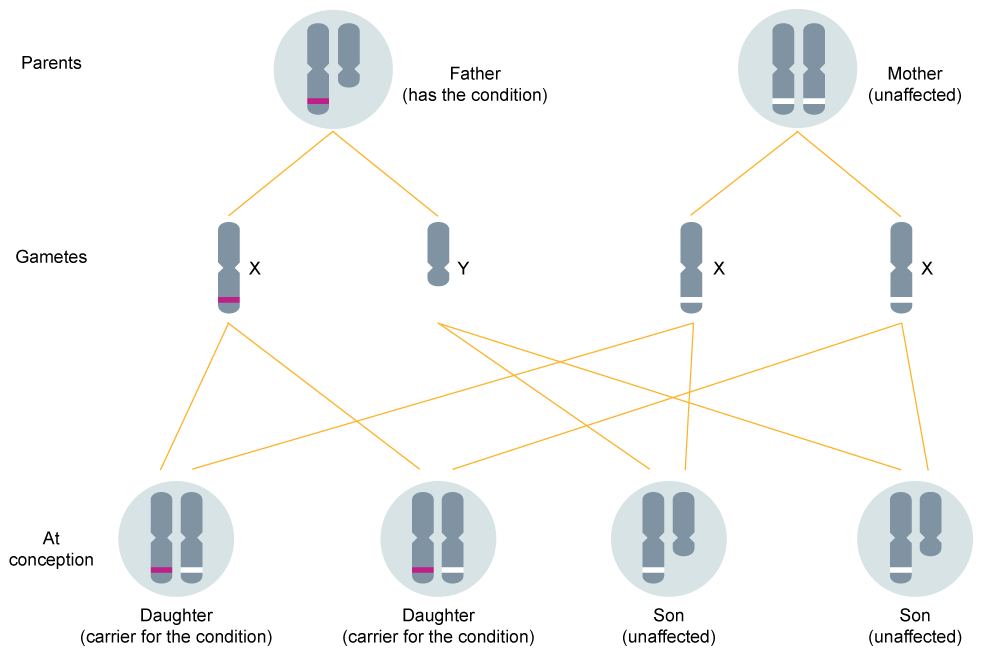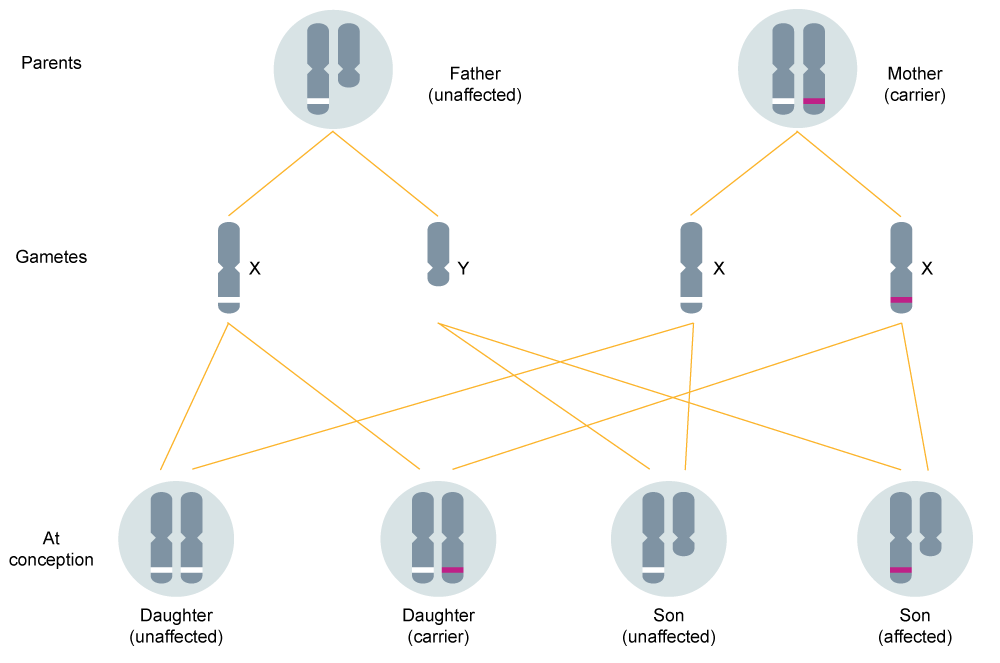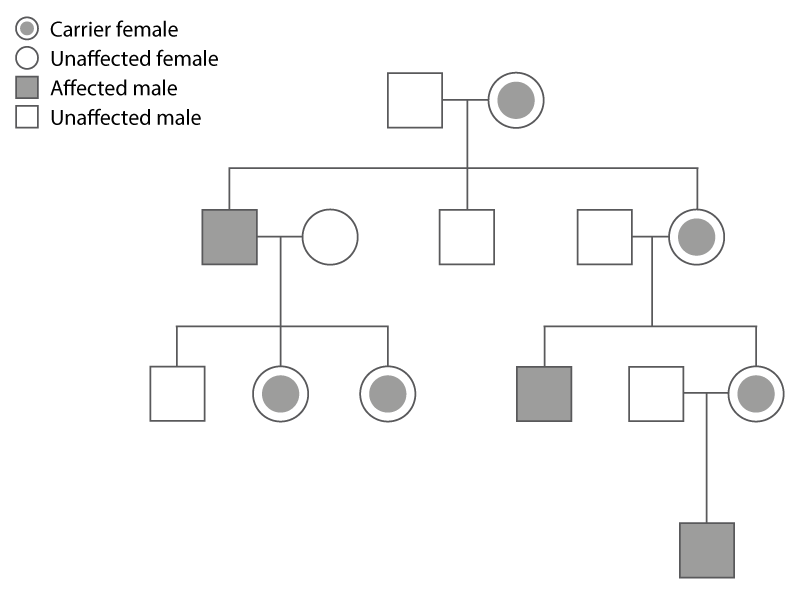X-linked inheritance
X-linked conditions occur when a pathogenic variant in a gene on the X chromosome leads to disease. In X-linked recessive conditions, males who carry the variant are affected, whereas females – who have a second non-pathogenic copy of the gene – are generally unaffected (or only mildly affected).
What is an X-linked condition?
X-linked inheritance relates to the genes that are passed on via the X chromosome. An X-linked condition occurs when a pathogenic variant in a gene on the X chromosome leads to disease.
Women have two X chromosomes (XX) and men have one X and one Y chromosome (XY). When considering X-linked inheritance, this difference between the sexes is important.
As males only have one copy of each X chromosome gene, if they carry the variant then they will be affected by the condition themselves. Fathers will always pass their X chromosome to their daughters and their Y chromosome to their sons.
Because females have two X chromosomes, carriers have a second non-pathogenic (or ‘wild type’) copy of the gene. This means that female carriers are usually not affected by X-linked recessive conditions, or affected only mildly. They may pass either X chromosome to their children.
Male vs female inheritance patterns
Where the father has the condition
Men who carry a pathogenic variant for an X-linked recessive condition will be affected.
As shown in figure 1, males pass on their Y chromosome to their sons. This means that sons cannot inherit an X-linked recessive condition from their affected father. Daughters, however, always inherit their father’s X chromosome and so all daughters will be carriers of the X-linked condition that their father has.

Figure 1: X-linked recessive inheritance where the father has the condition.
Watch this short animation to see the inheritance pattern in action.
Where the mother is a carrier for the condition
Females rarely show signs of X-linked recessive conditions, as they usually have a second unaltered copy of the gene on their other X chromosome. A female who has a variant on one of her X chromosomes that is associated with an X-linked recessive condition is referred to as being a carrier for that condition.
As shown in figure 2, when a mother is a carrier for an X-linked recessive condition, each daughter has a 1-in-2 (50%) chance of being a carrier for the same condition. Each son has a 1-in-2 (50%) chance of inheriting the variant and having the condition, as they only have one X chromosome.

Figure 2: X-linked recessive inheritance where the mother has the condition.
Watch this short animation to see the inheritance pattern in action.
Features of an X-linked recessive condition in a family
When looking at a family history, the presence of an X-linked recessive condition shows distinctive features, which can be identified by drawing a genetic family history, sometimes called a pedigree (see figure 3).
The main features of X-linked recessive inheritance include:
- affected males cannot pass the condition to their sons;
- males are affected almost exclusively; and
- the variant can be passed from unaffected female carriers to sons.

Figure 3: X-linked recessive inheritance within a family.
Why do female carriers sometimes have features of the condition?
Female carriers may manifest (usually mild) features of an X-linked recessive condition due to skewed X inactivation.
X inactivation is a normal phenomenon in women, whereby one of the two X chromosomes in each cell is shut down by epigenetic silencing. This avoids X chromosome genes being expressed at double the dosage of that in males. It’s usually random in each individual cell as to which X chromosome is inactivated (that inherited from the mother, or that inherited from the father), so overall there is usually around 50:50 expression from each X chromosome.
But, by various mechanisms, including (in some cases) because of a variant on an X chromosome, this X inactivation can be skewed. In the case of an X-linked condition, this can lead to decreased expression of the non-pathogenic (wild-type) allele, causing female carriers to manifest features of the condition.
Clinical examples
There are many known X-linked recessive conditions and likely many more not yet described. The table below lists a few of the more common X-linked recessive conditions that are seen in UK clinics.
| Condition | Gene | Salient features |
|---|---|---|
| Duchenne muscular dystrophy | DMD | Affected males experience onset in early childhood, with progressive muscle weakness and wasting, cardiomyopathy and reduced life-expectancy (typically 20s). Carrier females may be mildly affected and need cardiomyopathy surveillance. |
| Fragile X syndrome | FRX | This condition leads to intellectual disability, a characteristic facial appearance, behavioural issues and macro-orchidism in boys. Female carriers may be mildly affected. There are other phenotypes associated with premutation carrier status in either sex. |
| Haemophilia A | F8 | The condition is caused by low or absent levels of a blood clotting factor, resulting in prolonged bleeding arising either spontaneously or following minor injury. Complications may result from bleeding into the joints, muscles, brain or other internal organs. |
X-linked dominant conditions
An X-linked dominant condition describes a genetic condition caused by a variant in a gene on the X chromosome where only one copy of the altered gene is needed to cause the condition.
Therefore, both males and females can be affected by X-linked dominant conditions. Affected males tend to have more significant disease than affected females. In some cases the condition is so severe in males that they either die in utero or soon after birth.
Conditions inherited in this manner are quite rare. An example of an X-linked dominant condition is Rett syndrome.
Key messages
- X-linked recessive conditions are usually only present in males.
- Males with X-linked conditions cannot pass the variant on to their sons, but they always pass their affected X chromosome to their daughters. If the condition is recessive, their daughters will be carriers for the condition.
- Sons of female carriers of X-linked recessive conditions have a 1-in-2 (50%) chance of being affected by the condition.
Resources
For clinicians
- NHS England’s Genomics Education Programme: Genomics 101: Dominant, Recessive and Beyond
- NHS England: National Genomic Test Directory and eligibility criteria
For patients
- University Hospitals of Leicester NHS Trust: X-linked inheritance of genes